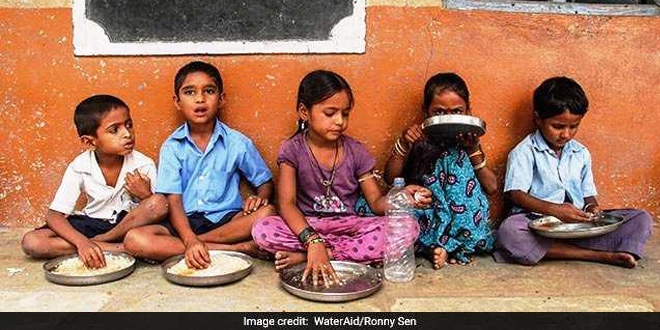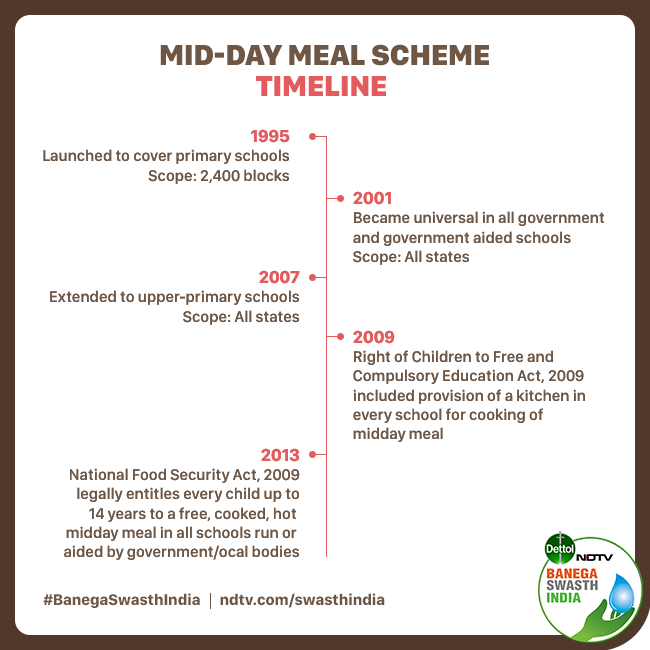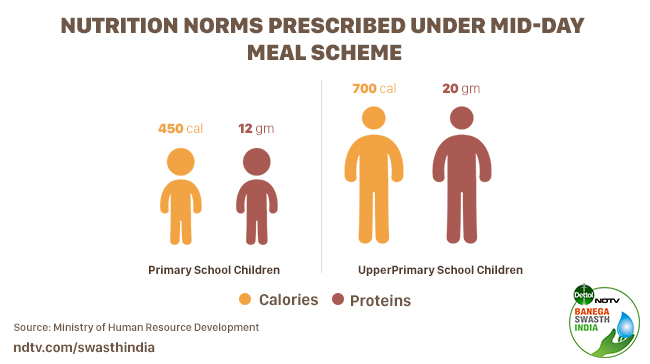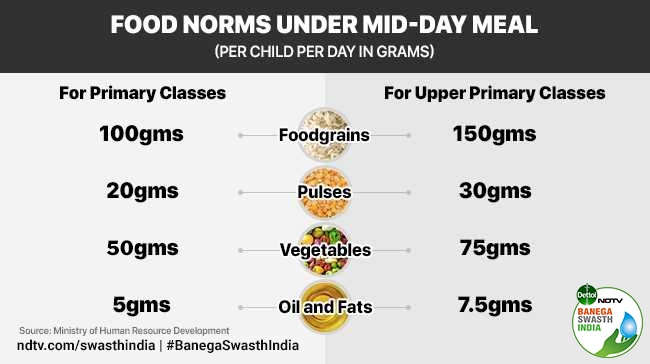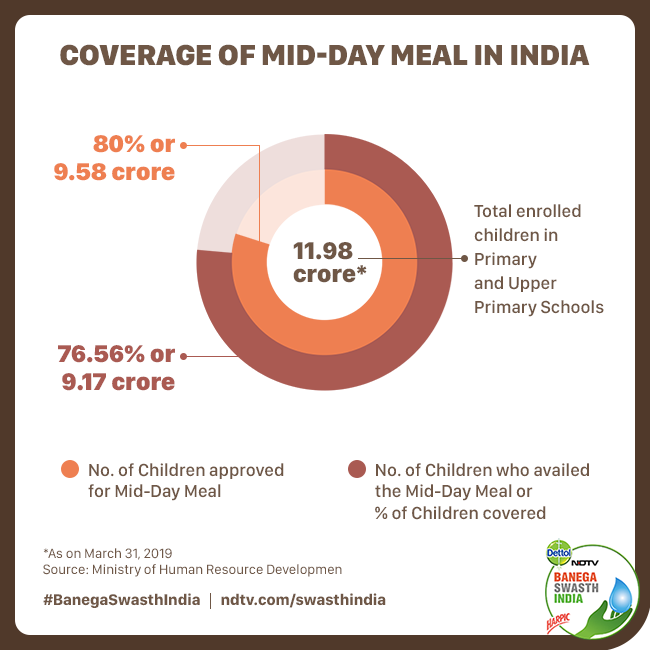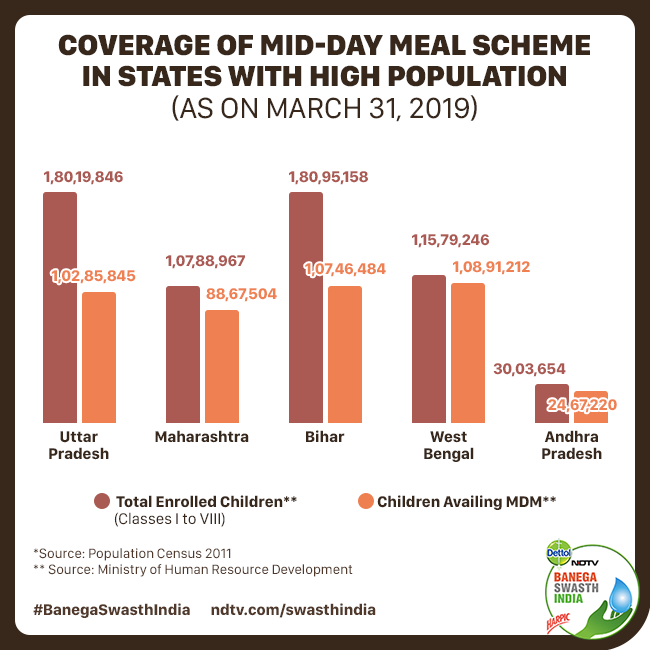New Delhi: Mid-Day Meal (MDM) scheme of India which is considered as the world’s largest school meal programme serving hot and freshly cooked meals to emaciated children, according to the Ministry of Human Resource Development (MHRD). As per the government data, in the year 2018-19, MDM scheme served about 9. 17 crore children in 11.35 lakh schools across the country. However, there have been many instances where the scheme has faced malpractices and slippages, like recently in Uttar Pradesh, multiple incidences of irregularities were reported like a school serving just ‘roti and salt’ to students in Mirzapur district of the state. Then in Sonbhadra district, one-litre of milk was mixed with a bucket of water to feed 81 students. In another school in Muzaffarnagar of up, a dead rat was found in cooked lentils when it was being served to the students, nine who had already consumed the dal fell sick. All these incidents were reported from one state in the span of three months. Similar instances have also come to light time and again from other states like in August 2018, in Jharkhand, an upper primary student had died and more than 60 were hospitalised allegedly after consuming contaminated meal at school. NDTV spoke with experts and government officials to understand the challenges in the effective implementation of MDM.
Evolution Of Mid-Day Meal
On August 15, 1995, the government launched the National Programme of Nutritional Support to Primary Education (NSPE) which is popularly known as mid-day meal (MDM). The scheme was launched in 2,408 blocks across the country for providing one meal per day to students in primary school (Class I to V). It was later made universal by extending the coverage to all government and government-aided schools in 2001, following the Supreme Court order dated November 28 of the same year. The scope of the scheme was further extended to cover the students of Upper Primary (Class VI to VIII) in 2007.
The programme received support from the Right of Children to Free and Compulsory Education Act, 2009 which mandated the provision of a kitchen in every school, where the midday meal would be cooked. Later, it was further strengthened by the National Food Security Act, 2013 which laid down the legal entitlement of every school child up to the age of fourteen years to a free, cooked, hot midday meal in all schools that are either run or aided by the government or local bodies.
According to Anshu Vaish who retired eight years ago from the office of Secretary, MHRD,
In its journey, MDM has faced the risk of phasing out the ‘hot freshly cooked meals’ for packaged ‘ready-to-eat meals’ in order to make the delivery of mid-day meals easier as distribution of packaged foods eliminated infrastructural requirements. Nevertheless, because of the constant advocacy from social activist groups like Right To Food Campaign and efforts of some government officials, this has not happened yet.
Also Read: This Initiative Of Young Warriors Feeds More Than 1000 Poor Children Daily
Meeting Nutritional Needs Of Children Through Mid-Day Meal
In terms of calorie intake, as per the MDM guidelines, the children in primary schools must be provided with at least 450 calories with 12 grams of protein through MDM while the children in upper primary schools should get 700 calories with 20 grams of protein, as per MHRD.
The food intake per meal by the children of primary classes, as provided by MHRD is 100 grams of food grains, 20 grams of pulses, 50 grams of vegetables and 5 grams of oils and fats. For the children of upper-primary schools, the mandated breakup is 150 grams of food grains, 30 grams of pulses, 75 grams of vegetables and 7.5 grams of oils and fats.
Impact of Mid-Day Meal Scheme
Avani Kapur, Reacher at the Centre for Policy Research (CPR) and Director of the Accountability Initiative (AI) asserted that while MDM is not the only factor on which learning outcomes depend, there is a positive effect of the scheme as nutrition level improves among the children who receive regular and wholesome mid-day meals. A study conducted by researchers from IIT (Indian Institute of Technology) Kanpur and ESMT (European School of Management and Technology) Berlin used data from nearly 600 rural districts in India, covering over 2 Lakh households and showed that children who receive mid-day meals have better reading and math scores.
Elementary and Social Education Professor Anita Rampal, Department of Education, University of Delhi highlighted that, often, for many families, the MDM can be an important social safety net in terms of a full balanced nutritious meal. She cited the findings of the National Institute of Public Cooperation & Child Development in Madhya Pradesh, Indore according to which there has been a reduction IN dropout rate in school-going children, particularly girls from the disadvantaged sections.
Also Read: Only 9 Per Cent Children Get Nutritious Food: Union Minister Smriti Irani
Challenges In Implementing Mid-Day Meal Effectively
At the level of Central Government, MDM comes under the purview of MHRD and at the state level, the programme is implemented by departments like education department or women and child development department of the Panchayati Raj department. In some states, the scheme is run in partnership between the state government and private organisations (Non-Governmental Organisations) like Akshaya Patra Foundation, and Annamrita among others.
While talking to NDTV about the implementation of MDM scheme, Elementary and Social Education Professor Anita Rampal, Department of Education, University of Delhi Mid-Day Meal said,
The huge scale at which MDM is being implemented currently, effective execution is not an easy task and makes it vulnerable to corrupt practices. It needs constant monitoring and strong grievance mechanism.
Talking about the challenges in the implementation of MDM, Avani Kapur, Researcher at the Centre for Policy Research (CPR) and Director of the Accountability Initiative (AI), said,
MDM is suffering with respect to the quality of food or inadequate nutrition content, poor infrastructure, and lack of community ownership in the community. In one of the reports presented to the Rajya Sabha on March 9, 2018, MHRD noted that lack of community participation is one of the reasons for the inadequate implementation of MDM scheme.
Ms. Kapur, however, acknowledged that the government has shown a positive outlook towards MDM in its annual budgets. In the budget 2019-20, MDM was allocated a sum of Rs. 11,000 crore which is about Rs. 500 crore more than the budget allocated in the year 2018-19. Nevertheless, Ms. Kapur says that while there is an increase in the overall budget for the programme, the cooking cost per child need to be increased too. Therefore she suggests that to account for inflation and ensure effective delivery, there should be an increase in the expenditure per child.
According to MHRD’s notice, dated June 24, 2019, the cooking cost per child per day is Rs. 4.48 for primary and Rs. 6.71 for upper primary children. To deliver MDM at this rate, in most states the centre contributes 60 per cent while the state’s share is 40 per cent. In the northeastern states, the contribution of the centre is 90 per cent and the respective state is 10 per cent and the scheme is funded 100 per cent by the central government in all union territories.
According to MHRD’s data, 11.98 crore children are enrolled in the primary and upper primary schools (from Class 1 to VIII) in the country in government schools and government-aided schools. Out of the total children enrolled, only about 76.5 per cent (9.17 crore) children benefitted under the MDM scheme as on March 31, 2019. However, the MDMs approved by the government was for a total of 9.58 crore children.
Talking about the reasons for the gaps in the enrolled, approved and availed data, Ashish Vyas, Mid-Day meal nodal officer, Department of Education, Government of Rajasthan said,
When a state seeks approval, it never seeks clearance for 100 per cent of the enrolled children because the everyday attendance in school is never 100 per cent. In Rajasthan, the average attendance in public schools in all the 33 districts of the state is 78 per cent. To avoid wastage of resource, the state government seeks approval on the basis of the average attendance in their respective states.
While the experts agree with Mr. Vyas’s explanation, they say that corruption can be one of the reasons for the gap in coverage. The performance audit report of the Comptroller and Auditor General (CAG) of India published in 2015 highlighted the corruption facing the scheme and lack of proper monitoring. For instance, it found that in Marihan block of Mirzapur district of Uttar Pradesh, 89.58 million tonnes of foodgrains valuing Rs. 4.47 lakh was lifted by district-level officials in October 2013 and foodgrains were delivered at irregular times to schools. Cases of malpractices and corruption were found in Ghazipur and Saharanpur districts also, as per CAG report of 2015.
Also Read: Here Are Tips On How To Tackle ‘Hidden Hunger’ In Children Caused By Lack Of Micronutrients
Among all the states in the country, Uttar Pradesh (UP), Bihar, and Jharkhand are the worst-performing states with mid-day meal coverage of 57.08 per cent, 59.39 per cent, and 61.45 per cent respectively, according to the data provided in Annual Work, Plan and Budget Reports of MDM by the Ministry of Human Resource Development (MHRD).
In Uttar Pradesh almost one fourth (4.3 crore) of its 20 crore people are aged between five and 14 years, according to the Population Census 2011, making it the state with highest child population in the country. UP has about 1.8 crore children enrolled for MDM in 1.5 Lakh primary and middle schools. The state has time and again made to the headlines for irregularities and corruption in the implementation of MDM. It has the maximum number of complaints (14) against corruption the implementation of MDM in the last three years, MHRD informed in its response to a question raised in Lok Sabha on November 25. The supervising body for MDM in the state, Uttar Pradesh Mid-Day Meal Authority, has devised an elaborate menu that is supposed to be served to the children at the state-run schools which includes pulses, rice, rotis and vegetables along with fruits and milk to be served on certain days. However, due to the poor quality of food served, in the past three years, a total of 154 children were reported ill, according to MHRD.
On the other hand, Kerala with 94.5 per cent coverage, Assam with 95.02 per cent, West Bengal 94.06 per cent, and Nagaland with 96.89 per cent are best performing states, as per MHRD data.
In Pics: Gurgaon’s Diksha School Fights Malnutrition By Feeding Mid-Day Meals To 400 Children
States To Take Lessons From
Some states like Andhra Pradesh, Maharashtra and West Bengal are performing much better among the highly populated states. In Andhra Pradesh, 82 per cent of children are availing MDM. According to MHRD, Andhra Pradesh provides eggs/bananas to children twice a week using the state’s own resources. Maharashtra with 82 per cent of MDM coverage has a unique practice of serving ‘sneh-bhojan’ (special treats which comprise sweets and snacks) to children on occasion of birthdays of eminent people of the state.
According to the data of MHRD, all states with literacy rates higher than the national rate of 74 per cent have shown a good performance under the mid-day meal scheme. For example, Kerala, the state with the highest literacy rate is also among the best performing states under the MDM scheme. The state provides additional food items like eggs/banana once a week and 150 mililitres of milk twice a week to each student. The state has recently announced that it will be adding 1 fruit per day with its regular meals.
Mizoram that has the second-highest literacy rate in the country serves mid-day meals to 92 per cent of its enrolled children. The state encourages schools to grow vegetables within the school compound because of which most schools in rural areas have their own kitchen gardens.
Similarly, Goa and Himachal Pradesh, where the MDM coverage is 87.5 per cent and 91 per cent respectively, are performing better than many other states in the country in terms of efficient fund usage, food quality and infrastructure, as per MHRD.
Also Read: How These Warriors Are Helping India Inch Towards A #ZeroHunger Country
Conclusion
According to experts, the best way to ensure effective implementation of MDM is through community participation and vigilance along with sustained government efforts. Ms. Kapur said,
The people need to ask the school authorities about the food being served, funds received and the quantity and quality of foodgrains procured for MDM.
Apart from continued community participation, the experts also call for awareness building among all stakeholders in the scheme on nutrition, health, hygiene and safety of food. Experts also highlight that efficient delivery is required for the positive impact of the scheme which includes increasing the staff involved in delivering the scheme on the ground and maintaining the quality of food served. Ms. Vaish says that with a budget as high as Rs. 11,000 crore, lack of proper staff and poor quality food is sheer lack of will on the part of the implementing agencies. The experts also emphasised on the need for building up proper data systems to track the scheme well. They call for better data keeping of the number meals served per day along with other details like items served and quality.
Also Read: This Mid-day Meal Initiative Is Changing Lives Of Over 60,000 School Children In Rajasthan’s Alwar


